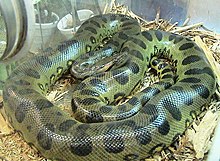Anaconda snakes are a group of large, non-venomous snakes found in South America. They belong to the genus Eunectes in the family Boidae. Anacondas are known for their impressive size and strength, with the green anaconda (Eunectes murinus) being the largest and heaviest snake in the world. Here are some key features and facts about anacondas:
Key Features
- Size: Green anacondas can reach lengths of up to 30 feet (9 meters) and weigh up to 550 pounds (250 kilograms), though most are smaller.
- Color and Pattern: They typically have an olive-green background with black blotches along their bodies, which provides excellent camouflage in their natural habitat.
- Habitat: Anacondas are primarily found in tropical rainforests, swamps, marshes, and slow-moving rivers, particularly in the Amazon and Orinoco basins.
- Behavior: They are excellent swimmers and spend a significant amount of time in the water. They are also capable of holding their breath for long periods while submerged.
Species
There are four recognized species of anacondas:
- Green Anaconda (Eunectes murinus): The largest and most well-known species.
- Yellow Anaconda (Eunectes notaeus): Smaller than the green anaconda, found primarily in Paraguay, Bolivia, and Argentina.
- Dark-spotted Anaconda (Eunectes deschauenseei): Found in northeastern South America.
- Bolivian Anaconda (Eunectes beniensis): A relatively newly identified species found in Bolivia.

Diet and Hunting
Anacondas are carnivorous and have a varied diet, which includes:
- Fish
- Birds
- Mammals (such as capybaras and deer)
- Occasionally larger prey, including caimans and jaguars
They use constriction to subdue their prey, wrapping their powerful bodies around the animal and squeezing until it suffocates.
Reproduction
Anacondas are ovoviviparous, meaning they give birth to live young. Females can give birth to a large number of offspring, with litters ranging from 20 to over 40 young snakes.
Role in Culture and Environment
Anacondas play a significant role in the ecosystems they inhabit by controlling the populations of their prey species. They have also captured human imagination and appear frequently in folklore, myths, and popular culture, often depicted as fearsome creatures.

Comments